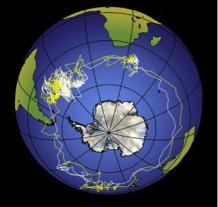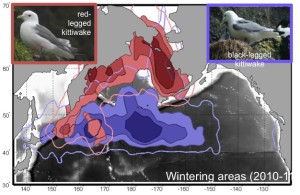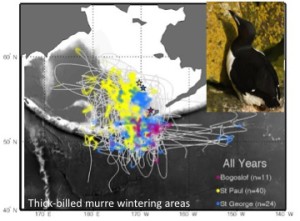We hear that Miss. Kushin’s class is learning about migration this week: butterflies; mammals, birds…
Don’t forget about Seabirds!
Seabirds return to land to build nests, lay eggs and raise their chicks. For those breeding on the Pribilofs this only takes a few months. These birds then spend the rest of the year at-sea. Some seabird species (like the pelagic cormorant) stay fairly close to their breeding location during the winter months, others fly miles to find a good food source.
Check out these incredible Seabird Migration stories:
(1) Sooty Shearwaters travel nearly 64,000 km (from New Zealand to the North Pacific Ocean) each year:
In the summer months you can sometimes see flocks of shearwaters just off-shore of the Pribilofs! Many of these are Short-tailed Shearwaters that breed in Australia.
(2) Arctic Tern migration is legendary! It’s been calculated that these tiny birds may fly 2.4 million km over their lifetime. That’s the equivalent to around three return journeys to the moon!
Arctic Terns breed in Alaska and some of these birds migrate all the way to the South Atlantic.
(3) Grey-headed albatrosses will actually circumnavigate the Southern Ocean when they are not breeding. One bird was able to complete this journey in only 46 days!

http://www.birdtracker.co.uk
(4) And, where are the Pribilof Island seabirds spending their winters?
Dr. Orben and colleagues have been using geolocators to find out where seabirds on the Pribilofs are traveling to in the winter months. Check out these cool maps showing where the kittiwakes and thick-billed murres spend their winter.
Questions for you:
(1) Both the shearwaters and the terns are almost always experiencing what season? Can you hypothesize (think of a reason) why that might be good for them?
(2) What seabirds do you see around during the winter? When do you start seeing kittiwakes and murres back on the cliffs?
Scientific References
Croxall JP (2005) Global Circumnavigations: Tracking Year-Round Ranges of Nonbreeding Albatrosses. Science 307:249–250
Egevang C, Stenhouse IJ, Phillips RA, Petersen A, Fox JW, Silk JRD (2010) Tracking of Arctic terns Sterna paradisaea reveals longest animal migration. Proceedings of the National Academy of Sciences 107:2078–2081
McKnight A, Allyn AJ, Duffy DC, Irons DB (2013) “Stepping stone” pattern in Pacific Arctic tern migration reveals the importance of upwelling areas. Marine Ecology Progress Series 491:253–264
Orben RA, Irons DB, Paredes R, Roby DD, Phillips RA, Scott A Shaffer (2015) North or south? Niche separation of endemic red-legged kittiwakes and sympatric black-legged kittiwakes during their non-breeding migrations. Journal of Biogeography 42:401–412
Shaffer SA, Tremblay Y, Weimerskirch H, Scott D, Thompson DR, Sagar PM, Moller H, Taylor GA, Foley DG, Block BA, Costa DP (2006) Migratory shearwaters integrate oceanic resources across the Pacific Ocean in an endless summer. Proceedings of the National Academy of Sciences 103:12799–12802



